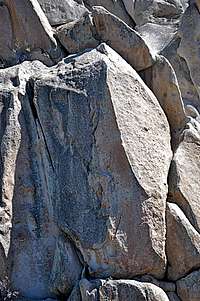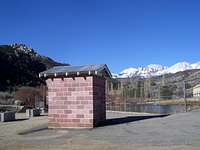-
 3232 Hits
3232 Hits
-
 83.1% Score
83.1% Score
-
 16 Votes
16 Votes
|
|
Mountain/Rock |
|---|---|
|
|
37.30330°N / 118.5242°W |
|
|
Inyo |
|
|
Trad Climbing, Sport Climbing |
|
|
Spring, Summer, Fall |
|
|
7000 ft / 2134 m |
|
|
Overview

Frontier is a rock formation in the Little Egypt area of the Eastern Sierras.
Because of the magnitude and complexity of Frontier, I divided the entire formation into two separate sections. I have already submitted a page on the Frontier, left side
. This page is dedicated solely to the middle to the right side. You will find the following subjects withing this page: a brief history, routes topo, route names and ratings, weather information, camping possiblities and directions.
Of the three major climbing areas in the Little Egypt rock formations, The Frontier contains the largest concentration of routes. The main reasons for this concentration are ease of access and rock quality. Frontier is the first rock formation you arrive at when you make the approach to Little Egypt. In contrast to Lambada Dome
and Mussypotemia
the rock quality is by far better. It was these facts that brought most of the activity to the Frontier area.
Although the approach to the Frontier formation is steep at first, it soon turns into an easy set of switch-backs that take you straight to the top of the ridge. From the ridge-top, you will get the best views of Mount Tom, Basin Mountain, Mount Humphreys and Mount Emerson I have seen. Besides the great mountain views, you will find yourself in a secluded area full of rock formations and small hills and valleys. Unfortunately, during the winter months the approach trail gets buried under several feet of snow. But during the spring and summer seasons, Frontier turns into a great playground for rock climbers.
Routes of the right side
Although most of the classic lines were established during the late seventies and early eighties, the route development did not stop there. At the present time, you can find a number of more difficult routes on bolted faces leading to excellent anchors for lowering or rappelling down. The old days of finding your way down the back side or making scary rappels off of ratty tree trunks or rattly rock horns are long gone. The fact of the matter is that if you are good enough to crank 5.12 and 5.13s in the back country at seven thousand feet, you should, at least, have the luxury of not having to trudge through obscure trails covered by sand and brush just to get back down. Many old climbers, such as this individual, have come to accept and even embrace the realities of modern day tactics.
Not to be left too far behind the left side classics, the Frontier’s right side has its own share of classic routes dating back to the late seventies and early eighties. One of the early pioneers on the Frontier was none other than Alan Bartlett with his first ascent of “Pyramid Power,” a dihedral crack rated at 5.9. Another crack system that was done in the early days and definitely qualifies as a classic is “King Tut’s Tomb,” rated at 10c.
Although it was the crack systems that received most of the attention at the Frontier during the early years, sport climbing made its own impact soon after. Two of such highly recommended face climbs are “Caravans, 10a” and “Welcome to The Dark Side. 10c.” And finally, for those looking for a challenge in a much higher difficulty level, there is one climb to name, and that is “Creme del Este, 13b,” a masterpiece established by the visionary climber, Kevin Thaw.
The Frontier, right side | |
| A | Cannibal, 11c, Standard rack |
| B | Pyramid Power, 5.9, two pitches, standard rack, pro to 3 inches |
| C | Creme del Este, 13b, bolts |
| D | King Tut's Tomb, 10c, Standard rack, pro to 3 inches |
| E | Jammin With Jane, 5.8, Standard rack, pro to 3.5 inches |
| F | Caravans, 10a, bolts |
| G | Welcome To The Dark Side, 10c, bolts |
| H | Arabesque, 5.9, bolts, standard rack |
Camping
There are many campgrounds along Bishop Creek. There are also many places in The Buttermilks are that are close to a creek that are suitable for camping. Please do not camp in The Buttermilks bouldering area. That area is very crowded and is suffering from the impact unregulated camping has caused.The following links should help finding a good campsite
Horton Creek Campground
Rock Creek Canyon
Inyo National Forest
Bishop Creek and vicinity camping














